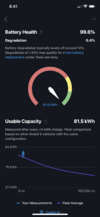So 17k miles and a 14% drop in less than a year. I'd personally be pretty concerned. I have 9k miles on my 2022 S (about 9 months on it) and I have less than a 1% drop. I have very hot summers and Texas and Florida. I almost never charge over 50% except when going on a long trip and I charge up just before I leave.22 Plaid with 17k miles. I charge to 90% every night which the Tesla guy said was perfectly fine.
So if I do the math, you've have maybe double my miles, have about 14x degradation and you live in a much cooler climate. I think I'll stick with my charging routine. For another reference point, the person who bought my Y, and lives in Texas, has a total of 38k miles. He has been following my charing protocol as much as possible but has one long commute each week of 280 miles. He charges at a higher level just for that.
His degradation is at 7% and many of the (20-25k) miles have been in pretty hot weather. He just charges up to 90% before he leaves and then keeps the charge level at 50% or lower when not on his long commute. Other than the one day, his typical commute is maybe 30-50 miles.



